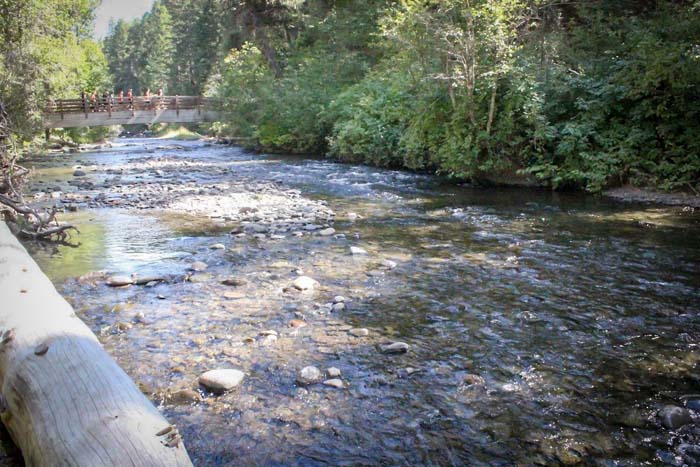A basket of memories
Published 1:39 pm Wednesday, March 30, 2022

- Dauble
Snow-Charged Streams and Days Gone By
Springtime in the Blue Mountains heralds the sound of passerine songbirds and snow-charged streams. While nature’s blessings brighten the spirit, sunlit days eventually remind of need to catch up on chores conveniently ignored over the darkness of winter.
Entering a garage cluttered with fishing gear and wood-working projects, my eye catches on Grandpa Harry’s ancient willow creel, aka fish box. I pull the creel down from the wall and lift its creaky lid. Bits of dried fern and the faint glitter of aged fish scales greet me. The syrupy sweet odor of fair-caught rainbow trout wafts from its interior like bacon grease plated on a cast iron skillet.
Fish boxes, as willow-weave creels were referred to in the “olden days,” are designed to hold a limit of fresh-killed trout. Their open weave design allows for water to drain off when dipped in the stream and for evaporative cooling of the day’s catch. A few decades ago, a basket-type creel was an important accessory for every serious angler. Nowadays they’re as obsolete as horsehair line. Not to mention that any self-respecting fly fisher who kills a fish in public waters stands a good chance of being ostracized by his peers.
A careful review of Hugh Chatham and Dan McClain’s classic reference, “The Art of the Creel,” provides insight on the origin of Grandpa’s creel. Such features as a “side-hole,” a single leather strap around the front and lid, reinforced back corners, and a 3-inch-wide leather flap hinge, suggest it’s a “Hazeldell,” product of the so-called king of the creel-leather business, George Lawrence Company of Portland, Oregon.
It would be difficult to prove the creel was made by G.L. Co. because it lacks a metal cartouche, engraving, or similar stamp of authenticity. Assuming the creel is an early G.L., though, it would be a No. 3 or the smallest of four sizes originally offered, having a capacity of 20 pounds (their largest, No. 7, was introduced in 1929 with a 40-pound capacity!). Since the horizontal weave or “weft” of Grandpa’s creel is whole willow, not split, as were early versions built in the wickerwork or French weave style, it closely conforms to No. 14x in the wicker-weave series, first built by G.L. in 1941.
The heirloom creel represents the last of Grandpa’s angling legacy after brother Dusty dumped a rubber raft on the Deschutes River and Grandpa’s bamboo fly rod sunk to the bottom of Whitehorse Rapids. The rub of it though, is the creel has fallen into disrepair. It’s not so much I ignore it when I pack my fly rod and vest, but why strap on a bulky creel in a catch-and-release world? Not to mention the occasional raised eyebrow when someone senses my goal is to fill a frying pan with a brace of trout. And, if and when I decide to keep a small trout for breakfast, it’s easy to slip the fish into the inside pocket of my fly vest.
The metal catch to the creel’s lid is missing and a “rolled” strip of leather designed to secure the shoulder strap has worn in two. There’s a small gap across the front where strands of willow have worked loose. A quick inventory of required components shows the need for 6 inches of leather to replace the worn handle, 12 inches of half-inch wide strapping for buckling the shoulder harness, and 2 feet of strap leather to secure the creel around my waist. The brass buckles have patina and can be reused.
I’ve fashioned several personal objects from leather: cowhide belts, deer skin moccasins, and a leather scabbard for an 8-inch hunting knife — to name a few. I once built a western-style coffee table covered with cowhide scraps; each piece carefully cut to match. Restoring Grandpa’s creel to good working condition is a welcome challenge. Cut leather to proper width and length, punch holes, attach snaps and rivets. That I can do.
The first order of business is to rub a liberal amount of Neatsfoot oil into badly cracked leather trim. I order a replacement shoulder strap with correct dimensions ($35 plus $10 shipping) from a fly shop in Wyoming. The brass buckle and tongue piece are salvaged from the original shoulder strap and a rear handle is fashioned from a short piece of rolled cowhide. The circa 1940 metal studs still function as if new. While not museum-quality, Grandpa’s creel is ready for action.
The old fish basket is a basket of memories, a keeper of faith, a vessel of my hopes and dreams. With stream trout season soon in my headlights, I long to hike up a fern-shrouded trail, inhale the honey sweet fragrance of mock orange, and watch butterflies flutter around a trailside seep. I want to place a Royal Coachman Bucktail (Grandpa Harry’s favorite pattern) where moss-covered boulders split the rush of swift current, set the hook on a pan-size “keeper,” and shove it through the square opening of the creel’s lid. The steady beat of the trout’s tail against inside willow weave is sure to leave a sweet fragrance to remind of days gone by.
Dennis Dauble is author of five books about fishing and fishing, including his latest, Chasing Ghost Trout. Contact him on his website DennisDaubleBooks.com.









